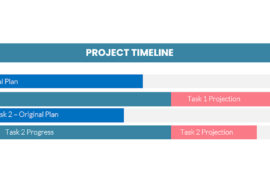I’ve been focusing a lot of my project management and timesheet conceptual energies lately on looking beyond what happens in each project task in a day and looking between them to everything else that happens in a day. That has led me to numerous subjects that I’ll talk about in the coming months. The project management industry has put enormous focus on being more efficient in task management over the last 6 or 7 decades. We have worked on how to best estimate tasks and how to sequence them for best performance. We think about how tasks would work better depending on the resources used and how we can streamline assignment information to each worker. If you were to think of improving task management efficiency you might make a dent of 1 or 2 percent with whatever technique you’d try.
At HMS we spend time thinking of project actuals of course because of TimeControl and collecting the timesheet information but because TimeControl is designed as an organization-wide timesheet, we also have to think of all the non-project tasks. If your timesheet is used for more than project progress, then you have to account for all your hours. Where does that time go?
In part, one of the things I’ve seen is that it goes into interruption.
The cost of interruption
There has been some great research done on the impact of interruption. One of my favorites is from Gloria Mark of The University of Irvine, California who wrote a paper called “The Cost of Interrupted Work: More Speed and Stress with Daniela Gudith and Ulrich Klocke of Humboldt University in Berlin. The paper looks at how much time people lose when interrupted before they get back to what they were doing before the interruption started. Twenty-three minutes and fifteen seconds is the mind-numbing answer. If you were thinking that getting an early start on your important project tasks would make the different, you would be sadly disappointed. On average people spend eleven minutes on a project before they’re interrupted.
That’s just brutal.
What kinds of things interrupt us?
In some cases it’s self-inflicted. You know those pop-ups that your phone delivers to make you look at who is liking your Instagram post? Interruption.
Text message? Interruption
Email pop-up notification to say you’ve got mail? Interruption.
The cost of these interruptions is not trivial. A 2005 Basex research paper estimated the costs of interruptions to be over $588 billion per year in the US alone.
The costs of interruptions are more than just monetized. They show up in other ways as well. An article by the Internet Marketing Association quotes studies that show that our average attention span went from 12 seconds in the year 2000 to only 8 seconds in 2013. That ranks humans below goldfish in attention. This same article quotes a study in the Journal of Experimental Psychology that even after a 2.8 second interruption, error rates double.
A few years ago the focus of interruption management was on emails. Many professionals receive hundreds of emails a day and if you are notified of each one, that represents a tremendous source of interruption. I can remember when I was spending a lot of time at Microsoft when a book by Sally McGhee was released called “Take Back Your Life”. It was about using Outlook to get and stay organized but one of the things it recommended that became an instant to-do in the division of Microsoft I was working on was to turn on Outlook’s instant notifications. The obvious cost of interruption too much.
At HMS staff are not permitted to use the Outlook notification task bar pop-up but just like HMS, many people have found a way around it.
Enter the world of Slack and Microsoft Teams. These instant messaging platforms have been terms “email-killers” because they allow staff to get instant messages at any time. These platforms are wonderful – for the interrupter. For someone in management like myself, being able to “ping” someone (like submarine sonar would ping for a target) and get an answer to my questions in a few moments is awesome. I feel so much more productive. But I am sure many interrupters – just like myself – don’t spend much time thinking about the impact on the interruptee. If we did, we might not be so quick to adopt instant messaging practices.
It should seem clear that many project staff are finding themselves less productive even though they are surrounded by productivity tools and processes. Some manage this by extending the office past office hours. Whether it is from a demand from the organization or due to a sense of diligence to deliver, some employees find themselves on call now 24×7 through instant message, text message, internet monitors and other mechanisms.
How can we mitigate the impact of interruption?
If you’re thinking it’s hopeless right now, you’d be wrong. There are many ways to mitigate the impact of potential interruptions. This is certainly true if you manage others but virtually everyone can adopt practices that minimize the way interruptions affect you.
Schedule your emergencies
Sound impossible? It’s not. When our technical staff at HMS are focusing on getting important work complete, we allow them to declare when they will be available for emergencies. We’re in the project management and timesheet management software business not neurosurgery. So long as a client knows when you’ll get back to them, they are almost always able to manage themselves until your call. So a staff person might say, “I’m available for urgent call after 11am” or something to that effect.
Delare a do-not-disturb period
Similarly, we allow staff to block themselves off for 3 or 4 hours at a time. We’ll ask them to check their email, check in with their supervisor and then lock themselves down with no email, no phones and no instant messaging. Then, for those 3-4 hours people can focus on the tasks at hand.
Use Flex-time
We often let staff stagger their schedules so that some people can get in much earlier or much later than normal working hours. This allows someone a solid couple of hours before the office gets going or after the office closes to get work done without interruption.
Redirect urgent traffic to a central source.
One way we have of managing excessive interruption in our office from urgent technical calls is to have a clearing house for them. We’ll declare one or a small number of staff to be fielding technical calls and reserve other staff to be working on development to solve previously identified problems or writing new software. It’s surprisingly effective.
All hands to the pumps!
My friend Tony used to say “It’s all hands to the pumps” whenever we would have something important that needed doing. Sometimes interruptions can best be managed by stopping everyone, putting everyone on the problem and solving it as quickly as possible.
To start with, be aware
The most important thing to do in the management of interruptions is to be aware that it happens and that it has a real cost. Look around you in the projects you manage or are involved in. Do you know how much non-project time occurs each day? Do you know what happens in that time?





